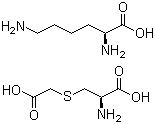- Product Details
Keywords
Quick Details
- ProName: Chondroitin sulfate
- CasNo: 9007-28-7
- Molecular Formula: H2O4S.xUnspecified
- Appearance: powder
- Application: food pharma nutrition healthcare produ...
- PackAge: 20kg/carton
- ProductionCapacity: /
- Purity: 99%
- Storage: storage in shady and cool warehouse
- LimitNum: 0
Superiority
1.USP/EP/BP/FCC/CP 2.GMP/DMF/KOSHER/HALAL/HACCP 3.10 Years Experience 4.Delivery within 5 days 5.OEM ability …
Details
1.USP/EP/BP/FCC/CP
2.GMP/DMF/KOSHER/HALAL/HACCP
3.10 Years Experience
4.Delivery within 5 days
5.OEM ability
1.Introduction of Chondroitin sulfate
Chondroitin sulfate is a sulfated glycosaminoglycan (GAG) composed of a chain of alternating sugars (N-acetylgalactosamine and glucuronic acid). It is usually found attached to proteins as part of a proteoglycan. A chondroitin chain can have over 100 individual sugars, each of which can be sulfated in variable positions and quantities. Chondroitin sulfate is an important structural component of cartilage and provides much of its resistance to compression.[1] Along with glucosamine, chondroitin sulfate has become a widely used dietary supplement for treatment of osteoarthritis.
.jpg)
2.Properties of Chondroitin sulfate
(1)ACD/LogP: -4.279 (2)# of Rule of 5 Violations: 2 (3)ACD/LogD (pH 5.5): -9.34 (4)ACD/LogD (pH 7.4): -9.99 (5)ACD/BCF (pH 5.5): 1.00 (6)ACD/BCF (pH 7.4): 1.00 (7)ACD/KOC (pH 5.5): 1.00 (8)ACD/KOC (pH 7.4): 1.00 (9)#H bond acceptors: 17 (10)#H bond donors: 9 (11)#Freely Rotating Bonds: 12 (12)Polar Surface Area: 287.45 ?2 (13)Index of Refraction: 1.686 (14)Molar Refractivity: 89.884 cm3 (15)Molar Volume: 236.121 cm3 (16)Polarizability: 35.633 10-24cm3 (17)Surface Tension: 136.501998901367 dyne/cm (18)Density: 2.03 g/cm3
3.Structure Descriptors of Chondroitin sulfate
SMILES:
O[C@@H]2OC(CO)[C@H](OS(O)(=O)=O)[C@H](O[C@@H]1O[C@H](C(O)=O)[C@@H](O)[C@H](O)[C@H]1O)[C@H]2NC(O)=O
Std. InChI:
InChI=1S/C13H21NO16S/c15-1-2-7(30-31(24,25)26)8(3(11(21)27-2)14-13(22)23)28-12-6(18)4(16)5(17)9(29-12)10(19)20/h2-9,11-12,14-18,21H,1H2,(H,19,20)(H,22,23)(H,24,25,26)/t2?,3-,4+,5+,6-,7+,8-,9+,11-,12-/m1/s1
Std. InChIKey:
SVZISYZJNFXEQQ-YLBYYDEWSA-N
4.Pharmacology use of Chondroitin sulfate
The dosage of oral chondroitin used in human clinical trials is 800–1,200 mg per day. Most chondroitin appears to be made from extracts of cartilaginous cow and pig tissues (cow trachea and pig ear and nose), but other sources such as shark, fish, and bird cartilage are also used. Since chondroitin is not a uniform substance, and is naturally present in a wide variety of forms, the precise composition of each supplement will vary. In fact, although many food supplement companies produce their products in compliance with human food processing Good Manufacturing Practice (GMP), most of them do not produce their products in compliance with the GMP regulations for pharmaceuticals, resulting in products without pharmaceutical requirements.
Recent testing has revealed several flaws in the older testing methods. Without knowing the source of the chondroitin (e.g., shark, porcine, or bovine) and the approximate age of the animal, it is impossible to get a reliable reference standard, and, thus, results from previous testing had yielded percentages between 50 and 400%. In 2007, David Ji et al. reported in the Journal of Analytical Chemistry an extremely accurate method of quantification. The method included using an enzyme to break the chondroitin into its individual unsaturated disaccharides, and then measuring them using HPLC with an ion-pairing column and UV detection.
5.Mechanisms of action of Chondroitin sulfate
The effect of chondroitin sulfate in patients with osteoarthritis is likely the result of a number of reactions including its anti-inflammatory activity, the stimulation of the synthesis of proteoglycans and hyaluronic acid, and the decrease in catabolic activity of chondrocytes inhibiting the synthesis of proteolytic enzymes, nitric oxide, and other substances that contribute to damage cartilage matrix and cause death of articular chondrocytes. A recent review summarizes data from relevant reports describing the biochemical basis of the effect of chondroitin sulfate on osteoarthritis articular tissues. The rationale behind the use of chondroitin sulfate is based on the belief that osteoarthritis is associated with a local deficiency in some natural substances, including chondroitin sulfate.
Recently, new mechanisms of action have been described for chondroitin sulfate. In an in vitro study, chondroitin sulfate reduced the IL-1β-induced nuclear factor-kB (NF-κB) translocation in chondrocytes.In addition, chondroitin sulfate has recently shown a positive effect on osteoarthritic structural changes occurred in the subchondral bone.
A review published in the Annals of Rheumatic Diseases describes all the documented evidence regarding the mechanisms of action of chondroitin sulfate.
6. Bioavailability and pharmacokinetics
Pharmacokinetic studies performed on humans and experimental animals after oral administration of chondroitin sulfate revealed that it can be absorbed orally. Chondroitin sulfate shows first-order kinetics up to single doses of 3,000 mg.Multiple doses of 800 mg in patients with osteoarthritis do not alter the kinetics of chondroitin sulfate. The bioavailability of chondroitin sulfate ranges from 15% to 24% of the orally administered dose. More particularly, on the articular tissue, Ronca et al. reported that chondroitin sulfate is not rapidly absorbed in the gastro-intestinal tract and a high content of labeled chondroitin sulfate is found in the synovial fluid and cartilage.
7. Package information
20kg/carton
.jpg)
8. Delivery information
Delivery within 5 days
.jpg)










